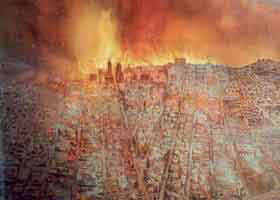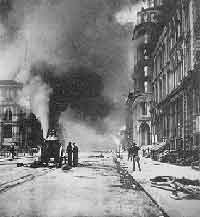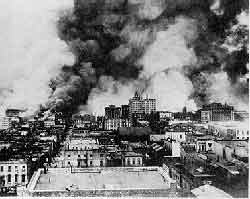
- Guardians Home
- SFFD Home
- Site Map
- Historical Review
- Apparatus
- Chiefs of Department
- Chronology
- Charles H. Ackerson
- Charles J. Brennan
- Keith P. Calden
- Andrew C. Casper
- Emmet C. Condon
- Robert L. Demmons
- John H. Dougherty
- Charles P. Duane
- Joanne M. Hayes-White
- George H. Hossefross
- Francis P. Kelly
- Frederick D. Kohler
- Joseph A. Medina
- Thomas R. Murphy
- William F. Murray
- Jeanine Nicholson
- Edward J. Phipps
- David Scannell
- Patrick H. Shaughnessy
- Albert J. Sullivan
- Dennis T. Sullivan
- Paul J. Tabacco
- Mario H. Trevino
- Edward P. Walsh
- Franklin E. R. Whitney
- Companies
- Events
- Past Events
- SFFD 150th Anniversary
- PPIE 100th Anniversary
- 1906 Expo
- 1989 Quake Party - 2009
- 65' Ladder Presentations
- Broderick & Terry Duel
- Coit Tower 75th Anniversary
- Cole Valley Fair
- Gold Hydrant - April 18th
- Jimmy's Car Show
- Lower Haight Street Fair
- Lotta's Fountain - April 18th
- Musters
- Presidio Car Show
- Station 28 75th Anniversary
- Fireboats
- Firehorses
- Firehouses
- Fires
- In The Line Of Duty
- Museum Collections
- Musters
- Notable People
- Organizations
- Gift Shop
- Volunteers
- Related Links
- Contact Us
- Research Requests
- Photo Gallery
- Videos
- Donations
| Great Fires: 1906 Great Earthquake & Fire
1906 Great Earthquake & Fire
On the morning of April 18, 1906, the first jarring shock of an earthquake struck at 5:12.06 AM and lasted 28 seconds. On that fateful morning the population was awakened to the terrifying spectacle of their city's destruction. Within a few hours 52 fires had started, many of which would have been general alarm blazes even under ordinary conditions. Before the flames were extinguished three days later, 478 persons were dead, including the Chief of the Fire Department, Dennis T. Sullivan, and the property loss was $350,000,000. The area burned was 4.7 miles square miles, which included all of the downtown territory. A two-alarm fire had broken out during the earlier part of the morning at Bay and Mason Streets, and most of the firemen in the downtown district had just turned in, dead tired, when the quake struck. The entire alarm system went out at the first shock. Of the 600 glass wet batteries operating the system, the earthquake broke 556 of them. As a result, not one alarm was ever sounded for this greatest of all fires! The main reservoirs for the city were twenty miles away; six miles of the distance was disclosed to be along the quake's "fault line" and was destroyed. Other pipe lines turned out to be in filled ground and were broken. Water had to be sucked from the cisterns that were soon dry, even from the large main sewers. A Chinese laundry on the south side of Howard near Third was one of the first to catch fire. It was across the street from No. 4 Engine. There was no water to fight with, and it soon got out of control. Hydrant after hydrant was tested without getting a drop. Far out in the Western Addition two big fires had broken out within two blocks of each other; another was burning at the corner of 22nd and Mission Streets. Downtown, dozens of fires were breaking out. Three engines, working tandem, pumped water 3,000 feet to put out the Western Addition fires; water found blocks away subdued the Mission Street fire. The apparatus worked its way toward the enormous fire downtown. Two State fireboats and Navy tugs were battling waterfront fires. The blasting of huge buildings was resorted to, but giant powder and nitro-glycerine being used, the explosions only spread the flames. While most of the department fought downtown, companies were also fighting large fires at Hayes and Laguna, Buchanan and Hayes, Golden Gate and Buchanan, Fulton and Octavia, and smaller ones in many other sections. A fire that started at Hayes and Gough several hours after the earthquake, got out of control because there was no water near. It swept over the Western Addition of Octavia and south of Golden Gate Avenue, crossed Market near Ninth and turned into the Mission district until stopped at Twentieth Street on the third day by water from a cistern at Nineteenth and Shotwell and one hydrant at Church and Twentieth. It was prevented from crossing wide Dolores Street by volunteers with buckets and wet sacks. The break in the 24-inch main on Howard and Seventeenth washed out a large hole, which soon filled with water. From that sump, four engines pumped. The department never stopped fighting, its men dropping from exhaustion and sleeping as they lay in the streets for a few minutes and then getting up and going after the fire again. It was almost impossible to get feed or water for the horses, and sometimes even fresh water for the boiler. Near the waterfront fresh water was taken off ships for the engines. That's how scarce water was. The fire had reached such proportions that a cistern at Second and Folsom Streets, holding 100,000 gallons, was drained without making the slightest impression. Most of the big downtown fires had combined into one, with the oncoming flames having at one time a three-mile front. The firemen, backing away doggedly and fighting without coordination because all communication had gone, began slowly to hem in the fire as dynamiting and small water supplies were effective on the outskirts. It was heart-breaking work, for time after time when it seemed a fire was being beaten, the water slowed from the hydrants or cisterns and then dribbled to a stop. Then came the search for another "tap." A strong west wind had sprung up too, causing great difficulty. Word that their beloved Chief Engineer Dennis T. Sullivan was dying from earthquake injuries spurred the men on to make a valiant battle for him, as he would have wanted done, had he been able to direct them.
Due to the heroic efforts of San Francisco firemen, assisted by soldiers, sailors, policemen, and the citizens of the city, much of Old San Francisco was saved. It was due to the fact that the San Francisco Fire Department was modern for its time that the Great Fire following the earthquake of April 18, 1906 was not far more disastrous.
REPORT OF THE FIRE DEPARTMENT On April 17, 1906, the Fire Department of the City and County of San Francisco was composed of 38 steam fire engine companies, 10 hook and ladder truck companies. 7 chemical engine companies, 1 water tower company, and 2 monitor batteries, with a unformed force of 584 men. They were in good condition and in regular service in the Department at that time. In addition to the above, there was also the following apparatus for relief, emergency and other purposes: 14 steam fire engines, 16 hose wagons, 2 water towers, 4 hook and ladder trucks, 14 officer's buggies, 6 hydrant carts, 10 delivery wagons, 2 supply wagons,1 crane-neck truck, 1 oil tank wagon, 1 horse ambulance, 1 hay wagon. The buildings of the Department then consisted of 44 engine houses, 2 corporation yards and repair shops, 2 drill towers, the Department stables, and corporation yard stables and headquarters of battalion chief, making fifty buildings in all. At Twenty-second and Mission Street, a fire broke out in a large three-story building, that was occupied as a dry-goods store, and which occupied nearly a quarter of a block. Through the energetic efforts of the engine companies stationed in that immediate vicinity, and with the aid of what little water that was obtained from a cistern on the corner of Twenty-second and Shotwell Streets, that was fortunately at their command, this fire was confined to the building in which it originated. Otherwise, all the Mission section of the City would have been destroyed. The result was that this fire was checked there and would not have extended farther west, but for a fire that broke out in the neighborhood of Gough and Hayes Streets at about ten o'clock that morning, had there been but the slightest quantity of water obtainable when this latter fire was discovered, it could have easily been extinguished, but we were compelled to watch it burn and spread. This is the fire that caused the destruction of the Mission district as well as the Hayes Valley section, including the Mechanics' Pavilion and the City Hall. In the wholesale district north of Market Street, many fires broke out. Though it was not impossible to check, the department was unable to stop them on account of the lack of water. The conflagration lasted for three full days, and at the end thereof, the members of this department, who had been continuously on duty, without sleep and barley sufficient food, were well-nigh exhausted. In conclusion we will state that the fire department of our municipality is today in as good condition in regard to discipline, efficiency, etc., as it was on April 17, 1906, and with the acquiring of additional apparatus, tools, etc., to replace those destroyed, and the establishment of a large commodious repair shop, for the repair and manufacture of our apparatus, together with the erection of substantial buildings to replace the temporary structures hastily erected to house the burned out companies after the fire, we have no hesitancy in declaring that the San Francisco Fire Department will again assume its place in the foremost rank of the fire departments of the world in regard to its efficiency and completeness of its equipment and appliances for battling with fire. San Francisco Municipal Report |




 Relentlessly the flames went on through the days and nights of the 18th, 19th and 20th. In the early dawn of April 21, the great fire had been beaten. The department had finally won, but at tremendous cost. The department lost twenty of its installations and fourteen pieces of equipment. More than one half of all department hose also was destroyed by the flames. Its highest ranking officer was dead. But the fire was out at last.
Relentlessly the flames went on through the days and nights of the 18th, 19th and 20th. In the early dawn of April 21, the great fire had been beaten. The department had finally won, but at tremendous cost. The department lost twenty of its installations and fourteen pieces of equipment. More than one half of all department hose also was destroyed by the flames. Its highest ranking officer was dead. But the fire was out at last.